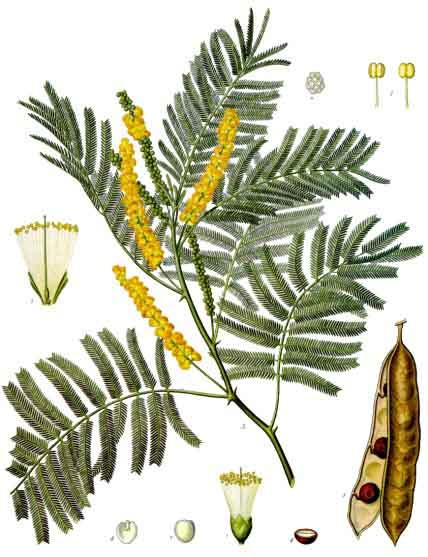
Acacia catechu (Willd.)
Synonyms: Catechu
nigrum, cutch, dark catechu
Order: Leguminosae
Description: This tree is indigenous to eastern India, Bangladesh and Burma.
Parts used: dried extract from the heartwood, occurring in commerce as black shining pieces or cakes.
Collection: The bark and sapwood are stripped from the felled tree and the heartwood cut into pieces and boiled with water. The decoction is then evaporated to a syrup and allowed to cool in moulds. The resulting dried mass is broken into irregular pieces.
Constituents: 20-35% tannins, mainly catechutannic acid; 2-10% acacatechin, quercetin and catechu-red.
Actions: Antiseptic, strong astringent
Indications: Chronic diarrhoea, dysentery, mucous colitis, as a douche in leucorrhoea, and as a mouthwash or gargle in gingivitis, stomatitis and pharyngitis.
Therapeutics and Pharmacology: Acacia is a useful remedy for arresting excessive mucous discharges and checking haemorrhages. It may be used as a douche for leucorrhoea or as a mouthwash or gargle for pharyngitis, laryngitis, gingivitis and stomatitis. Acacia has a very high tannin content and is therefore an excellent astringent for overcoming relaxation of the mucous membranes in general. Externally, it can be applied in the form of a powder to boils, ulcers and cutaneous eruptions as well as to spongy gums.
Combinations: It may be combined with Acorus, Mentha piperata, Filipendula, Agrimonia and Quercus in lower bowel conditions. It may be used with Commiphora and Hamamelis as a gargle for pharyngitis, tonsillitis or gingivitis.
Caution: Incompatible with alkalis, lime water, metallic salts and gelatin.
Preparation and Dosage: (thrice daily)
Regulatory status GSL
Dried extract: 0.3-2g or by infusion
Tincture: 1:5 in 45% alcohol, 2.5-5ml
Additional Comments: The resin from the heartwood of black catechu can be used to tan leather, and it also produces a brown dye. Pale catechu (Uncaria gambier Roxb.) may be used medicinally in the same way but is slightly less astringent.
Bibliography
BHMA 1983 British Herbal Pharmacopoeia, BHMA, Bournemouth.
Grieve, M. 1931 A Modern Herbal, (ed. C.F. Leyel 1985), London.
Hoffmann, D. 1990 The New Holistic Herbal, Second Edition, Element, Shaftesbury.
Lust, J. 1990 The Herb Book, Bantam, London.
Mills, S.Y. 1993 The A-Z of Modern Herbalism, Diamond Books, London.
Wren, R.C. 1988 Potter's New Cyclopaedia of Botanical Drugs and Preparations, C.W.Daniel, Saffron Walden.










